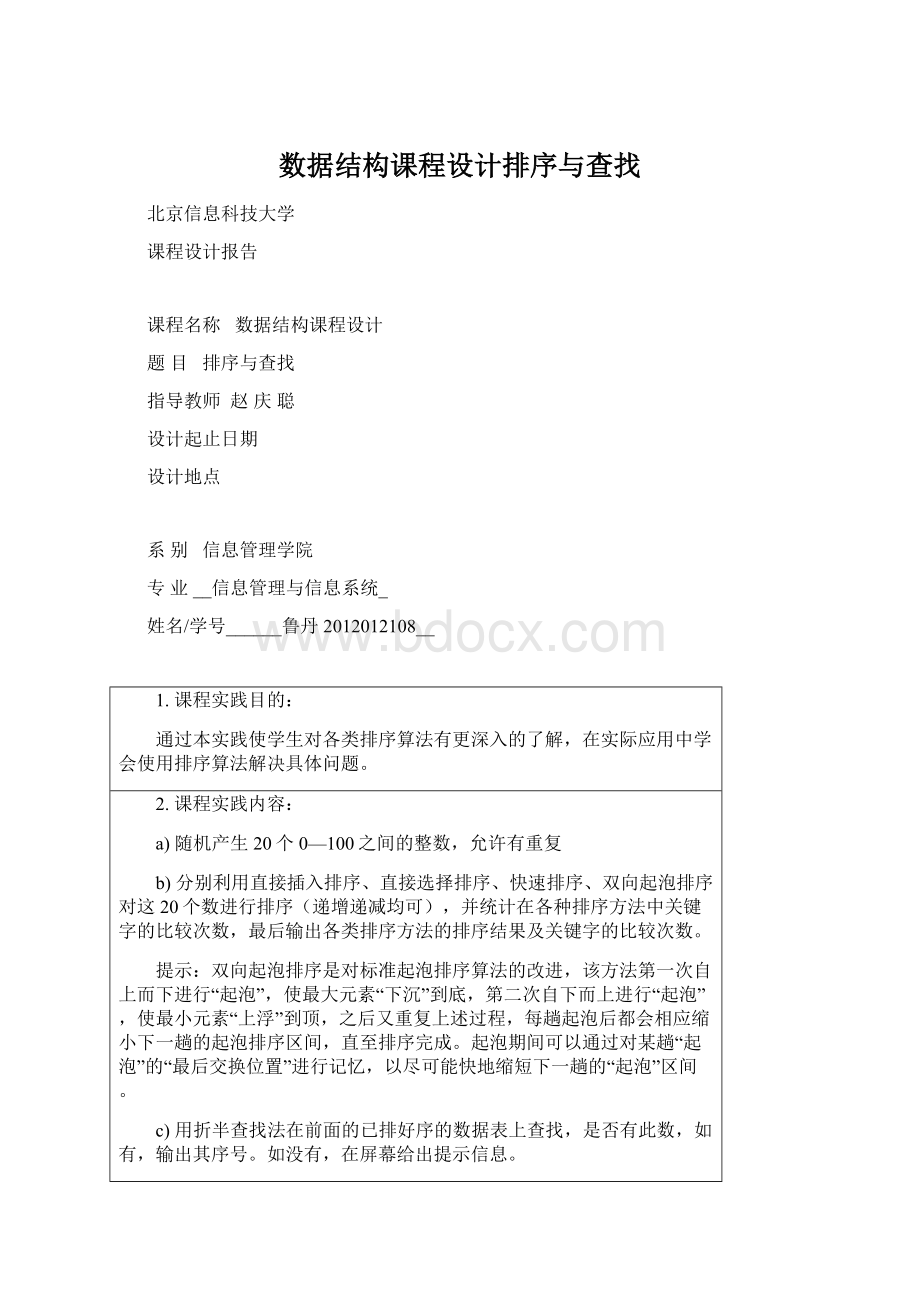数据结构课程设计排序与查找.docx
《数据结构课程设计排序与查找.docx》由会员分享,可在线阅读,更多相关《数据结构课程设计排序与查找.docx(17页珍藏版)》请在冰豆网上搜索。

数据结构课程设计排序与查找
北京信息科技大学
课程设计报告
课程名称数据结构课程设计
题目排序与查找
指导教师赵庆聪
设计起止日期
设计地点
系别信息管理学院
专业__信息管理与信息系统_
姓名/学号______鲁丹2012012108__
1.课程实践目的:
通过本实践使学生对各类排序算法有更深入的了解,在实际应用中学会使用排序算法解决具体问题。
2.课程实践内容:
a)随机产生20个0—100之间的整数,允许有重复
b)分别利用直接插入排序、直接选择排序、快速排序、双向起泡排序对这20个数进行排序(递增递减均可),并统计在各种排序方法中关键字的比较次数,最后输出各类排序方法的排序结果及关键字的比较次数。
提示:
双向起泡排序是对标准起泡排序算法的改进,该方法第一次自上而下进行“起泡”,使最大元素“下沉”到底,第二次自下而上进行“起泡”,使最小元素“上浮”到顶,之后又重复上述过程,每趟起泡后都会相应缩小下一趟的起泡排序区间,直至排序完成。
起泡期间可以通过对某趟“起泡”的“最后交换位置”进行记忆,以尽可能快地缩短下一趟的“起泡”区间。
c)用折半查找法在前面的已排好序的数据表上查找,是否有此数,如有,输出其序号。
如没有,在屏幕给出提示信息。
3.实践步骤:
#include
#include
#include
#defineN100
#defineOK1
#defineERROR0
#defineLIST_INIT_SIZE100
#defineLISTINCREMENT10
#defineINFEASIBLE-1
#defineOVERFLOW-2
typedefintStatus;
typedefintElemType;
typedefstruct{
ElemType*elem;
intlength;
intlistsize;
}List;
StatusInitList(List&L)
{
L.elem=(ElemType*)malloc(LIST_INIT_SIZE*sizeof(ElemType));
L.length=0;
L.listsize=LIST_INIT_SIZE;
returnOK;
}//InitList
voidCreate(List&L,intn)
{
inti;
srand(time(NULL));
for(i=0;i{
L.elem[i]=rand()%N;
L.length++;
printf("%d",L.elem[i]);
}
printf("\n");
}
intInsertSort(ListL)
{
inti,j,t,m;
m=0;
for(i=1;i{
t=L.elem[i];
j=i-1;
if(t>=L.elem[j])
m++;
else
m++;
while((j>=0)&&(t{
L.elem[j+1]=L.elem[j];
j--;
}
L.elem[j+1]=t;
}
returnm;
}
intSelectSort(ListL)
{
inti,j,k,min,t=0;
for(i=0;i{
min=i;
for(j=i+1;jif(L.elem[j]{
min=j;
t++;
}
elset++;
if(min!
=i)
{
k=L.elem[i];
L.elem[i]=L.elem[min];
L.elem[min]=k;
}
}
returnt;
}
intQuickSort(ListL,ints,intt)
{
inti=s,j=t,count4=0;
if(s{
L.elem[0]=L.elem[s];
do
{
while(j>i&&L.elem[j]>=L.elem[0])
{
j--;
count4++;
}
if(i{
L.elem[i]=L.elem[j];
i++;
}
while(i{
i++;
count4++;
}
if(i{
L.elem[j]=L.elem[i];
j--;
}
}
while(iL.elem[i]=L.elem[0];
QuickSort(L,s,j-1);
QuickSort(L,j+1,t);
}
returncount4;
}
intBubbleSort(ListL)
{
intflag,i,j;
intt=0;
flag=1;
while(flag==1)
{
flag=0;
i=0;
for(j=L.length-i;j>i;j--)
{
if(L.elem[j-1]>L.elem[j])
{
flag=1;
intm;
m=L.elem[j];
L.elem[j]=L.elem[j-1];
L.elem[j-1]=m;
t++;
}
elset++;
}
}
returnt;
}
voiddisplay(ListL)
{
inti;
for(i=0;i{
printf("%d",L.elem[i]);
}
printf("\n");
}
voidmain()
{
ListL;
intlow,high,a,b,c,d;
InitList(L);
printf("请将随机产生的0-100间的20个数输出:
\n");
Create(L,20);
printf("\n直接插入法排序输出的顺序表为:
\n");
a=InsertSort(L);
display(L);
printf("此排序法关键字比较的次数为:
%d\n",a);
printf("\n直接选择法排序输出的顺序表为:
\n");
b=SelectSort(L);
display(L);
printf("此排序法关键字比较的次数为:
%d\n",b);
printf("\n快速排序输出的顺序表为:
\n");
c=QuickSort(L,1,20);
display(L);
printf("此排序法关键字比较的次数为:
%d\n",c);
printf("\n双向起泡法排序输出的顺序表为:
\n");
d=BubbleSort(L);
display(L);
printf("此排序法关键字比较的次数为:
%d\n",d);
}
1.#include "stdio.h"
2.#include "stdlib.h"
3.#include "string.h"
4.#include "time.h"
5.#include "limits.h"
6.#define MAXITEM 1000
7.typedef int KeyType,ElemType;
8.int count1=0,count2=0,count3=0,count4=0,count5=0,count6=0;
9.int swap1=0,swap2=0,swap3=0,swap4=0,swap5=0,swap6=0;
10.typedef struct rec
11.{
12. KeyType key;
13. ElemType data;
14.}sqlist[MAXITEM];
15.
16.void gennum(sqlist r,sqlist t,int n)
17.{
18. int i;
19. srand((unsigned)time(NULL));
20. for(i=1;i<=n;i++)
21. { t[i].key=rand()%100;
22. r[i].key=t[i].key;
23. }
24.}
25.
26.void ini(sqlist r,sqlist t,int n)
27.{
28. int i;
29. for(i=1;i<=n;i++)
30. r[i].key=t[i].key;
31.}
32.
33.void BubbleSort(sqlist r,int n)//起泡法r[1]~r[n]
34.{
35. int i,j;
36. struct rec w;
37. for(i=1;i<=n-1;i++)
38. for(j=n;j>=i+1;j--)
39. {
40. if(r[j].key41. {
42. w=r[j];
43. r[j]=r[j-1];
44. r[j-1]=w;
45. swap1++;
46. }
47. count1++;
48. }
49.
50.}
51.
52.
53.void InsertSort(sqlist r,int n)//直接插入排序r[1]~r[n]
54.{
55. int i,j;
56. for(i=2;i<=n;i++)
57. {
58. count2++;
59. r[0]=r[i];
60. j=i-1;
61. while(r[0].key62. {
63. r[j+1]=r[j];
64. j--;
65. count2++;
66. swap2++;
67. }
68. r[j+1]=r[0];
69. swap2++;
70. }
71.}
72.
73.void SelectSort(sqlist r,int n)//简单选择排序r[1]~r[n]
74.{
75. int i,j,k;
76. struct rec temp;
77. for(i=1;i<=n-1;i++)
78. {
79. k=i;
80. for(j=i+1;j<=n;j++)
81. if(r[j].key82. if(i!
=k)
83. {
84. temp=r[i];
85. r[i]=r[k];
86. r[k]=temp;
87. swap3++;
88. }
89. }
90.}
91.
92.void QuickSort(sqlist r,int s,int t)//快速排序r[s]~r[t],r[0]空出
93.{
94. int i=s,j=t;
95. if(s96. {
97. r[0]=r[s];swap4++;
98. do
99. {
100. while(j>i&&r[j].key>=r[0].key){j--;count4++;}
101. if(i102. {
103. r[i]=r[j];
104. i++;
105. swap4++;
106. }
107. while(i108. if(i109. {
110. r[j]=r[i];
111. j--;
112. swap4++;
113. }
114. }while(i115. r[i]=r[0];
116. swap4++;
117. QuickSort(r,s,j-1);
118. QuickSort(r,j+1,t);
119. }
120.}
121.
122.void ShellSort(sqlist r,int n)//希尔排序r[1]~r[n]
123.{
124. int i,j,gap;
125. struct rec x;
126. gap=n/2;
127. while(gap>0)
128. {
129. for(i=gap+1;i<=n;i++)
130. {
131.
132. j=i-gap;
133. while(j>0)
134. if(r[j].key>r[j+gap].key)
135. {
136. x=r[j];
137. r[j]=r[j+gap];
138. r[j+gap]=x;
139. j=j-gap;
140. count5++;
141. swap5++;
142. }
143. else
144. {
145. j=0;count5++;
146. }
147. }
148. gap=gap/2;
149. }
150.}
151.
152.void sift(sqlist r,int l,int m)
153.{
154. int i,j;
155. struct rec x;
156. i=l;
157. j=2*i;
158. x=r[i];
159. while(j<=m)
160. {
161. if(j162. if(x.key163. {
164. r[i]=r[j];
165. i=j;
166. j=2*i;
167. count6++;
168. swap6++;
169. }
170. else {j=m+1;count6++;}
171. }
172. r[i]=x;
173.}
174.void HeapSort(sqlist r,int n)//堆排序r[1]~r[n]
175.{
176. int i;
177. struct rec m;
178. for(i=n/2;i>=1;i--)sift(r,i,n);
179. for(i=n;i>=2;i--)
180. {
181. m=r[i];
182. r[i]=r[1];
183. r[1]=m;
184. swap6++;
185. sift(r,1,i-1);
186. }
187.}
188.
189.void main()
190.{
191.
192. int k,n,a;
193. sqlist r,t;
194. printf(" ***************************************\n");
195. printf(" * *\n");
196. printf(" * * 内部排序算法的性能分析 * *\n");
197. printf(" * *\n");
198. printf(" ***************************************\n\n");
199.
200. printf("-----------------*-------------------------------------*----------------\n");
201. printf("**是否执行程序**\n");
202. printf("(是) 按 1 键, (否) 按 0 键\n");
203. printf(" 按键为:
");
204. scanf("%d",&a);
205. printf("-----------------*-------------------------------------*----------------\n");
206.
207. while(a==1)
208. {printf("**请输入要排序的数据的个数:
");
209. scanf("%d",&n);
210.
211. gennum(r,t,n);
212. printf("\n");
213.
214. printf("**随机产生的最初顺序是:
\n");
215. for(k=1;k<=n;k++)
216. { printf("%3d",t[k].key);
217. if(k%20==0)
218. printf("\n");
219. }
220. printf("\n");
221. BubbleSort(r,n);
222. printf("\n**排序之后的顺序是:
\n");
223. for(k=1;k<=n;k++)
224. { printf("%3d",r[k].key);
225. if(k%20==0)
226. printf("\n");
227. }
228. printf("\n\n");
229. printf("-------------------------------*分析结果*-------------------------------\n\n");
230. printf(" **起泡排序**\n");
231. printf(" 比较的次数是:
%d,